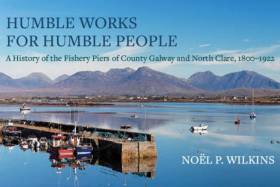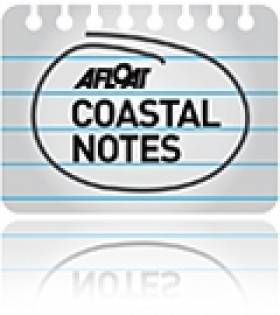Displaying items by tag: Piers
Humble Works for Humble People: The History of Fishery Piers & of Galway & North Clare
This beautifully illustrated book explores the history of the fishery piers and harbours of Galway and North Clare. A testament to these structures as feats of engineering, it is also a riveting account of the human aspect that shadowed their construction; a beautiful rendering of the maritime activities that gave life to the Wild Atlantic Way – kelp-making, fishing, turf distribution, and sea-borne trade.
Humble Works for Humble People nurtures the retelling of human stories surrounding the piers, giving voice to the unacknowledged legacy of the lives that were their making. Foreign financial support, humanitarian efforts, controversies and conflict – these are all features of the piers and harbours’ development and preservation. Humble Works for Humble People is a vital contribution to the maritime history of Galway, Clare and of Ireland in general; an overlooked but culturally rich facet of Irish history.
Buy the book online from Afloat.ie's Marine Market here.
€23m Package for the Repair of Storm Damaged Public Piers, Harbours & Slipways (Funding List Here)
"In addition, a further €14.63m of funding is being provided for harbour development in 2014 and this represents a significant increase on the level of funding provided in 2013. This is an indication of the Government's commitment to developing our fishery harbours for the benefit of our fishing industry, seafood processing sector, other ancillary marine industries, tenants and the wider community. It is part of an ongoing and long term strategy to develop and improve the facilities at our Fishery Harbour Centres and other public harbours around our coast." (see table 3 below for details).
€11.63m of this is allocated towards safety, maintenance and new development works at six Fishery Harbour Centres at Howth, Dunmore East, Castletownbere, Dingle, Ros a Mhíl and Killybegs, in addition to infrastructural improvement works at "bull nose" pier, North Harbour, Cape Clear. This works also includes €4m for dredging works at Dunmore East.
€3m is being allocated for Local Authority Harbour Development and Marine Leisure programmes. The Department is contacting the relevant Local Authorities in relation to applications under this element of the Programme.
Flagship projects in the 2014 Capital Programme include the works at "bull nose" pier Cape Clear, major dredging works at Dunmore East, electrical upgrading in Howth, slipway works at Ros a Mhíl, Castletownbere and Dingle, and a small craft harbour in Killybegs.
The Minister commented that "the projects consisting of €23m in total capital expenditure will repair the storm damage to our vitally important fisheries piers and harbours network and will develop our harbours for the benefit of our seafood industry and the coastal communities dependent on this infrastructure. This package will help to ensure that this important infrastructure is fit for purpose in the modern era and will bring significant added value to local communities and much welcome jobs and economic activity".
Kerry Harbour Users Say No to Over-Regulation
#IRISH HARBOURS - Protesters took to the water off Kerry's piers last month in an organised swim drawing attention to proposed harbour bylaws designed to regulate the activities of water users.
“We need to make the public aware they have to make submissions,” Denise Collins told The Irish Times from Kells, which hosted one of the largest swims. “Traditional activities such as swimming will be over-regulated, we fear.”
The proposed bylaws would give Kerry County Council greater control over 16 of the county's 57 harbours and piers, including Kells, Kenmare, Portmagee, Brandon and Ventry.
Under the new bylaws, strict regulations would be placed on the use of loudhailers, landing and unloading passengers and freight, waste and even movement around the harbour.
"Draconian" charges are also set to be imposed on fishermen and other harbour users, while campaingers also feel that a ban on swimming and diving could also be added to the list.
The proposed bylaws already suffered a set-back earlier this year when Kerry County Councillors decided to restart the consultation process to allow the fishing industry, tourism operators and other interests more time to make submissions.
According to the Irish Examiner, only two submissions had been received by the council as of its January monthly meeting, despite senior council officials working for months on the draft proposals.
Cllr Toiréasa Ferris commented that the proposed charges in particular "would have huge implications for fishermen, some of whom might currently be earning only between €40 and €50 for a 14-hour day."
As previously reported on Afloat.ie, charges may also soon be hiked on yachts berthing at Ireland's main fishing harbours, a list that includes Dingle in Co Kerry.
Irish Marine Federation chairman David O'Brien expressed concern at the potential for such charges to damage "the good tourism dividend for coastal towns", noting that for every euro spent on a harbour berth, €10 was normally spent in the locality.
Warrenpoint Harbour Authority
Warrenpoint Harbour Authority
Warrenpoint Harbour Authority seeks to operate profitably within fair and competitive tariff arrangements so that the Port is economically sustainable. Its aim is to contribute as much as possible to the generation of economic wealth within the Port and its regional hinterland.

Consequently, profit optimisation, to achieve its primary mission rather than profit maximisation, will be pursued.
History
The original Port of Warrenpoint, consisting of a wet dock and piers, was constructed in the late 1770s by Roger Hall, Robert Ross and Isaac Corry with the assistance of £500 of public funds. In 1919 the heirs of Roger Hall sold the Port to John Kelly and Sons for the sum of £16,000. John Kelly continued to operate the Port until 1971 when it was sold to Warrenpoint Harbour Authority for £369,000.
The Port was substantially enlarged with an initial total investment of approximately £6.7million to create the modern Port of Warrenpoint. Until 1971 the Port of Warrenpoint acted as a lightering port for the Port of Newry and jointly these ports handled approximately half a million tonnes of cargo annually. Subsequently the modern Port of Warrenpoint has handled 5 times as much cargo on an annual basis.
Warrenpoint Harbour Authority, The Docks, Warrenpoint, Co. Down, N. Ireland BT34 3JR. Administration/General Enquiries – Tel: 028 417 73381 • Fax: 028 417 52875. Operations – Tel: 028 417 52878 • Fax: 028 417 73962• Email: [email protected]































































